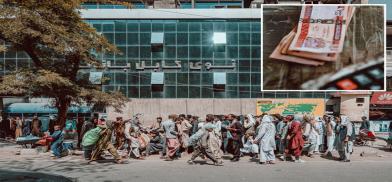How bad is Afghanistan’s economy? Recipe for a failed state
Extractive institutions ensured that the limited gains of growth in Afghanistan were cornered by political elites like warlords, writes N. Chandra Mohan for South Asia Monitor

There are no words to describe the tragedy unfolding in Afghanistan. Three-fifths of its 38 million people may go hungry this winter. In normal times, half the population was poor, subsisting on less than $1.90 a day. Poverty may become near-universal by mid-2022.
Following the takeover by the Taliban in August, Afghanistan’s economy has collapsed, with the national output of goods and services or gross domestic product (GDP) likely to contract by as much as 20-30 percent this year after the Covid-19-related plunge of 2.4 percent in 2020, according to the World Bank. The country faces a humanitarian and economic disaster.
Afghanistan’s woes, however, are not of recent provenance. They are long-standing as it has been racked by political instability and institutional weakness. Afghanistan has remained dirt-poor – its per capita income of $509 in 2020 is one of the lowest in the world -- largely because of extractive institutions which result in lack of property rights, law and order or well-functioning legal systems and the stifling dominance of national and, more often, local elites (read warlords) over political and economic life, according to Daron Acemoglu and James Robinson in their book “Why Nations Fail: The Origins of Power, Prosperity and Poverty”.
A country surviving on aid
Afghanistan is an aid-dependent economy that received $150 billion of non-military aid from the US, plus billions more from its allies and international organizations from 2001 to 2020. Grants financed 75 percent of public expenditure and 50 percent of the budget. High aid inflows drove the service economy in cities like construction, procurement and employment opportunities associated with spending by government and aid agencies. Private sector activity unrelated to aid or security like manufacturing was constrained by deep-rooted political instability and corruption, according to the South Asia Economic Focus of the World Bank.
All this foreign aid didn’t transform Afghanistan’s economic fortunes as it remained poor. Between 2013 and 2020, the average annual GDP growth was a lowly 2.2 percent with the size of the economy smaller in 2020 than in 2013. Per capita income steadily declined in absolute terms over this period, indicating deteriorating living standards of Afghans.
Extractive institutions ensured that the limited gains of growth in Afghanistan were cornered by political elites like warlords. Foreign aid was siphoned off, if not plundered, with only 10 or at most 20 percent of aid reaching its intended target. Aid did not improve life for ordinary Afghans.
Aid promotes education
However, some of the aid did make a difference in building healthcare facilities and schools, particularly for girls, in areas where none existed before. Around 20,000 elementary schools and a number of universities were built. Enrollment of students rose from 900,000 in 2001 to 9.5 million. The number of enrolled in higher education increased from 7,000 in 2001 to about 200,000 in 2019.
From no female college students in 2001, there were 54, 861 in 2019. The share of girls among all students reached 39 percent in 2020 versus only 5,000 in 2001, according to Mohammad Qadam Shah, Assistant Professor of Global Development, Seattle Pacific University.
All these gains are now likely to be frittered away with the takeover by the Taliban. There is a sudden cutback in aid inflows while the US has frozen the $9 billion of Afghanistan’s forex reserves. This is triggering a collapse in health and education facilities, including payment of salaries to teachers. The government cannot pay civil servants.
Adding to these challenges are unpaid soldiers and exodus of professionals, according to Omar Sadr, an Assistant Professor at the American University of Afghanistan, Kabul, who is currently at the University of Pittsburgh, in a panel discussion organized by the South Asia Institute (SAI), Heidelberg University and South Asia Monitor (SAM).
The upshot is that Afghanistan’s aid-dependent economy faces the prospect of a free fall. Firms and households are unable to access savings and cash for transactions. The banking system is facing serious stress. There is no money to pay for even essential imports. Drought conditions in the countryside have resulted in shortages of food grains. All of these contribute to a severe contraction in output and production and accelerating inflation this year.
Impending crisis
With such a deep recession in the economy, the plunge in living standards makes for a serious humanitarian crisis as Afghans sink further into poverty and starvation and hunger stalk the land.
Unfortunately, there will be no respite for Afghanistan as the Taliban is unlikely to be able to govern. As the SAI-SAM panel discussion underscored, there is also a great degree of uncertainty over the group’s cohesion in the coming months amid reports of growing tensions within the Taliban among different groups and influential clans. Mullah Haibutullah Akhundzada, the group's reclusive leader, for instance, hasn't so far appeared in public. All of this is a recipe for a failed state with extractive institutions.
(The writer is an economics and business commentator based in New Delhi. His views are personal. He may be contacted at nchandramohan@rediffmail.com)










Post a Comment